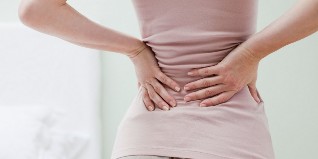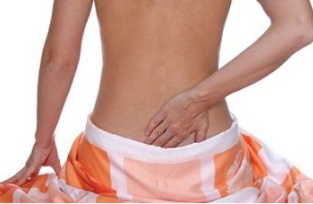Most often a sore lower back because the lumbar spine has the greatest mobility and to bear the weight of the upper half of the body. Pain in the lumbar region has a separate address — for lumbago, if she gives into the leg — sciatica. Rarely, pain occurs in the thoracic spine. If the pain is acute and extends (gives) in the page or on the arm, it is called "lumbago" or "sciatica". This type of pain usually associated with compression of the spinal nerve.

Back pain and lower back pain can occur suddenly when lifting heavy, to awkward, to turn. Sometimes back pain develops gradually over a number of years, of effort or improper posture. Rarely the cause of pain cannot be determined. Pain may worsen at night, under load or after a long finding in an inconvenient pose, for example, after the long trip in the car. Often the pain disappears when lying down on a flat hard surface.
In most cases, pain in the back, in a few days or weeks and then I feel better, and mobility is completely restored. For fast healing of the help of pain relievers and a special way of physical activity: rest only in the first 1-2 days of especially intense pain and then gradual return to an active lifestyle. However, in some cases, the back or the lower back, pain lasting more than 6 weeks. Then when talking about the development of chronic back pain and prescribe additional treatment.
Plays important role your mood. Due to pain, you may be difficult to maintain a good mood, but studies show that positive-minded people generally recover faster than those who are in depression.
Causes of back pain
Back health depends on the smooth functioning of the complex mechanism of bones, muscles, nerves and joints. Often accurately determine the cause of the pain can be difficult. Fortunately, serious illness or back injury, are rare. Most often the pain in the back or back caused light injuries, muscle tension, stretching muscles and ligaments, of the violation and inflammation of the nerves. Back pain can occur suddenly or develop gradually on the rise. Possible causes for pain in the back and the cross:
- awkward movement: tilt or rotation of the housing;
- lifting and carrying of heavy objects, prolonged bending of the torso;
- posture when walking or sitting;
- excessive stretching of the back muscles;
- the long-term run without stopping.
Sometimes back starts the disease for no apparent reason, for example, in the morning, after sleep.
Risk factors for back pain
Certain risk factors increase the likelihood of back pains or lower back:
- Excess weight, while the spine to bear more load. If you want to determine whether your weight is normal, calculate the body mass index.
- Smoking — may cause harm to the tissues of the back, and smokers are generally less likely to lead a healthy lifestyle.
- Pregnancy — the woman's spine is subject to an additional load, which increases with the amount of stomach.
- Long-term consumption of medications that reduce bone density, such as corticosteroids.
- Stress is believed to constant anxiety raises muscle tension back and neck, which can cause pain.
Diseases that can cause pain in the back and the cross:
- Osteochondrosis and its complications, such as herniation of the spine — degenerative disease, in which collapse of the intervertebral cartilage, which causes pain. These diseases often develop with age, especially in those people who are experiencing heavy load at the back.
- Stretching of the ligaments and muscles — which often occurs after excessive physical exertion or awkward movement.
- Different types of arthritis, inflammatory diseases of the joints. In this case, in addition to pain, marked morning stiffness in the joints, impaired mobility.
- Kidney disease, such as pyelonephritis can cause pain in the lower back.
There are also more dangerous, but very rarely causes back pain. For example, cancer, tuberculosis of the spine, aortic aneurysm (separation of the walls of large blood vessels), etc .. these are usually diagnosed during examination by a doctor.
The diagnosis of pain in the back and t.j. the remainder

With pain in the back and lower back can often cope at home with medication sold at the pharmacy without a prescription. Hospital treatment is normally not necessary. If the pain is severe, seek a doctor's help doctor. If pain does not give you to move, you can call the doctor at home.
During the examination the doctor will ask you to sit, stand, walk, alternately lift your feet and will also check range of motion in the back. It may ask you about previous illnesses or injuries to your way of life and the nature of the work, as well:
- When the pain started?
- Where does it hurt?
- Mind back in the past?
- Can you describe the pain?
- From what the pain escalates or is it?
Research and review, the doctor will attempt to rule out the possibility of infection and fracture, although they are very rare. In the case of disputed diagnosis, you may be referred to additional studies: magnetic resonance imaging (MRI) or x-ray of the spine. To avoid kidney disease the doctor orders a urine.
In most cases, back pain is not removed in a few days. If the treatment does not help, back pain, lasting more than 6 weeks (the so-called chronic back pain), or the cause of the disease is a serious disease, the therapist will refer you to a specialist. Most often the treatment of back pain and pain in the low back, which deals with the neurologist. In addition, the treatment can be linked with the doctor, as osteopath, reflexologist, chiropractor.
The treatment of back and lumbar
The treatment of low back pain may depend on its duration and severity, as well as your personal wishes and needs. Most often, the pain can be removed with the use of non-prescription medicines and treatment at home.
Motor way
In the past years, it was believed that when the pain in the back, you should rest. It is now accepted that people who get up early for faster management of low back pain and low back pain. Complete quiet and bed rest is available only for 1-2 days in the acute stage, when pain is very strong and does not move. In this case, it is recommended to lie on the hard and smooth surface. As soon as the condition is slightly improved, you should gradually return to a mobile life, expanding the range of motion a little each day.
Gradually you can move around the house or for shopping. You put up with some discomfort and learn to avoid anything that causes severe pain. A few days later, you can return to work without waiting for the moment when the pain in the back or the cross will be completely (of course, if your work is not connected with the excessive load on the spine). Early activation will get you back to normal daily routine and distraction from the pain.
Muscle relaxants
Are medications that relieve spasm of skeletal muscles, relax the muscles. They are appointed in the cases, when excessive tension of the muscles of the spine increased the pain, in order, for example, when aggravation of degenerative disc disease or disc herniation. Muscle relaxants have side effects, many of them can not take the bike. Therefore, it is necessary to consult a doctor.
The treatment of heat and cold

Some pain helps to warmth, e.g. hot bath or heating pad on the painful site. Also relieve the condition can be cold, for example, to be used for lower back ice or package of frozen vegetables. Do not apply ice directly to the skin, as this may cause frostbite. Wrap in a damp towel and apply to the affected area. You can also alternate heat therapy with cold, apply alternating ice and heating pad.
Position for sleeping
Changes in the posture of sleep, you can relieve the tension from the back and relieve pain. If you sleep on your side, slightly pull the leg to your chest and place a pillow between your legs. If you want to return back, place a pillow under the knees to support the natural curve of the spine in the lumbar region.
Release
This is a very important component of dealing with pain, because if you worry too much, it will cause muscle tension, which can exacerbate the pain. Studies show that positive-minded people tend to recover faster. The pain from them, it comes in a long, chronic. There are a variety of relaxation techniques. As a rule, it is advisable to learn breathing exercises and simple exercises with alternate tension and relaxation of different muscles of the body.
Exercise and a healthy lifestyle
Try to resolve the cause of pain in the back, to prevent it from returning in the future. The most common causes of back pain — excess body weight, poor posture and stress. Regular exercise and an active lifestyle will help your back, that will be strong and healthy. Most people prefer to do walking, swimming and yoga. What is most important — decide what you like and does not cause pain. Sometimes classes are held in groups under the guidance of skilled instructors. Usually classes run exercises to strengthen the muscles and improve the posture as well as aerobic exercise and stretching exercises.
The treatment of chronic pain in the back
If back pain lasts more than 6 weeks (the so-called chronic back pain), in addition to analgesics and muscle relaxants used are described below methods of dealing with pain. This therapy can help those who have back pain prevents performing normal routine and alarming.
The prevention of back pain
Strong and flexible back is the best way to prevent pain. It is therefore the most effective prevention is regular physical exercise, proper posture and safety when lifting and carrying heavy loads.
If you have the occasional back pain, try the following:
- If you want to lose weight, if obese. Too much body weight can put additional lower back stress.
- Wearing orthopedic shoes with a low heel, to reduce the load on the spine during walking.
- Avoid sudden movements that may cause stretching of the muscle.
- To learn how to deal with the stress, the anxiety and the worry that can increase pain in the back.
Proper posture and sound sleep with back pain
Posture, which has a significant impact on the health of your back. Standing always keep the body straight, head straight, not to hunch. Distribute the weight evenly on both legs, do not bend them. Sit up straight, with an emphasis on the lower back. Knees and hips should be level and your feet are firmly on the ground (if necessary, use a footstool). It is sometimes convenient to below the waist a small pillow or rolled up towel. If you enter on the keyboard, the forearms must lie horizontally, and the knees should be bent at a right angle.
If you spend a lot of time behind the wheel, make sure the chair is a emphasis for the waist. If you adjust the side view mirrors, you do not need to bend the back. The Pedal should be right in front of your feet. On a long trip, regular stops to stretch your back.
Sleep is to serve as a place for relaxation of the whole body, also on the back. However, this requires a fairly hard mattress, so as not to bend under the weight of the body from shoulders to buttocks, like a hammock. If the bed is too soft, place a firm Board or the Committee (ideally 2 cm thick) under the mattress. The head should lie on the pillow, but the neck should not be bent at a great angle.





































